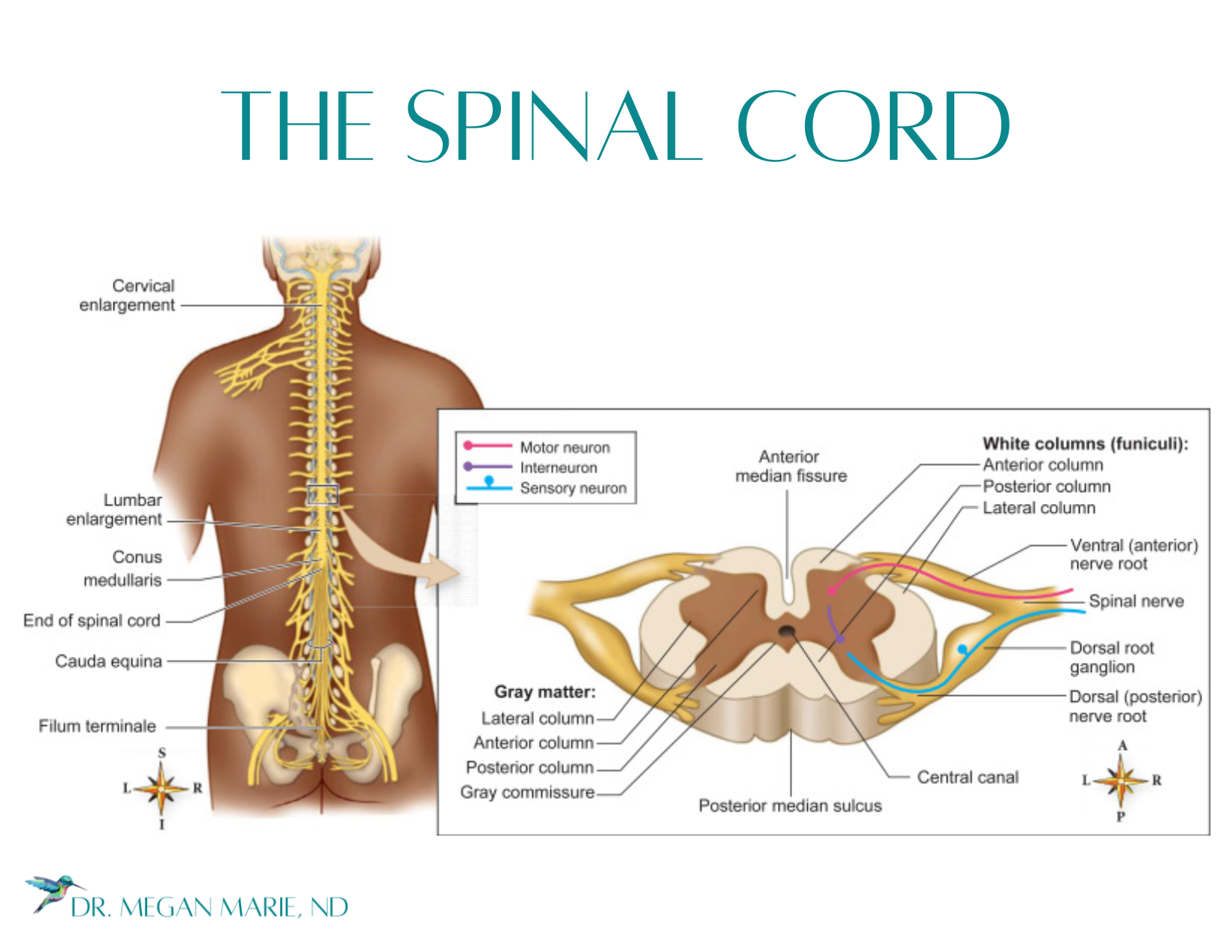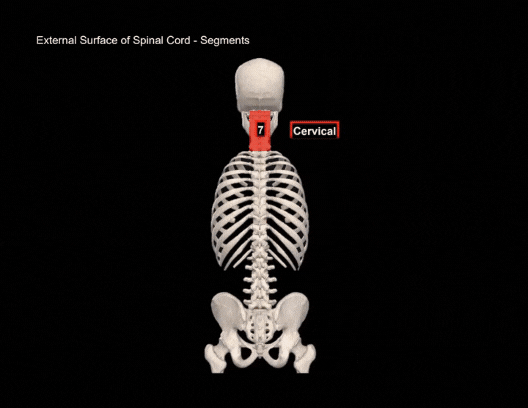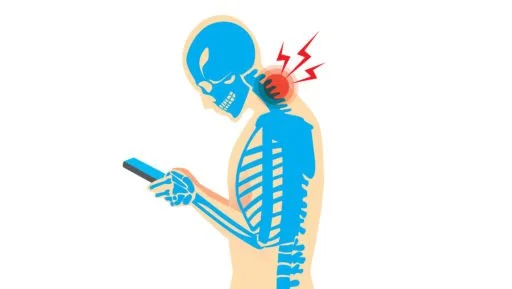The Spinal Cord
The capacity of the brain is truly incredible. But what is amazing mental capacity without a way to literally “make it matter?” That’s where the spinal cord comes in. Without the spinal cord, the brain would just be potential—like a brilliant detective with no assistant to gather clues.
The spinal cord transforms the brain’s potential into reality. It’s the central nervous system’s “superhighway,” transmitting signals between the brain and the peripheral nervous system. When you think about picking up a cup, the spinal cord ensures that thought becomes action. Likewise, when you stumble, your body senses the uneven ground and sends that signal up to your brain for quick analysis. It’s a constant dialogue between body and brain—Dr. Watson collecting observations and Sherlock Holmes solving the mystery.
Photo edited from here.
ANATMOMY AND STRUCTURE
Think of the spinal cord like an expertly bundled cable system, running from the brainstem to the lower back. It’s a continuous tube of neural tissue—up until about the level of the L1-L2 vertebrae, where it transitions into a structure called the conus medullaris (a cone-shaped taper). Below this point, the spinal cord branches into a bundle of nerve roots called the cauda equina, which translates to “horse’s tail” in Latin because of its striking resemblance.
Why this shift? If the spinal cord continued as a rigid tube all the way to the coccyx (the tailbone), it would severely limit our ability to bend, twist, and move. By branching into flexible nerve roots, the nervous system adapts to the body’s need for mobility while remaining protected from the stresses of everyday movement.
At different levels of the spine, the spinal cord adjusts to the body’s functional needs:
Cervical Region: Thinner but packed with nerve traffic to the arms and head.
Thoracic Region: Narrower, as it mainly serves the trunk and has less motor activity compared to the limbs.
Lumbar and Sacral Regions: Thicker to accommodate the dense nerve bundles serving the legs and lower body.
The vertebrae surrounding the spinal cord are uniquely shaped to both protect it and allow flexibility:
Cervical vertebrae: more delicate and mobile to support head movement.
Thoracic vertebrae: rigid to anchor the ribs and provide stability for the trunk.
Lumbar vertebrae: sturdier to bear the body’s weight and allow for bending and lifting.
This design highlights the elegance of the spinal cord and vertebral column working together—combining protection, flexibility, and efficient signal transmission.
CONNECTIONS TO THE BRAIN: WHY IT MATTERS
The spinal cord works in tandem with the brain, acting as both a messenger and a decision-maker depending on the situation:
Reflexes: Some actions, like pulling your hand away from a hot stove, are handled by the spinal cord itself. This is because reflex arcs bypass the brain to ensure a fast response. The spinal cord initiates the movement, protecting you before the brain even processes the sensation of heat or pain.
Conscious Processing: After the spinal cord triggers the reflex, the signal is sent up to the parietal lobe, where your brain interprets the sensation as heat. This is where you become consciously aware of what happened and can decide what to do next, like turning off the stove.
This collaboration between instinct and intellect allows the nervous system to act quickly when necessary or take its time with conscious thought.
Balance and Coordination: The spinal cord relays signals between your body and brain to keep you steady. When you step onto a rocking boat, your spinal cord sends sensory information about the shifting ground to the cerebellum, which makes split-second adjustments to your posture.
Body Awareness: Your spinal cord transmits signals about your body’s position (proprioception) to the brain, ensuring that when you reach for a glass in the dark, your hand lands in the right place.
HEALTH AND HEALING (THE BODY AS A CONNECTED SYSTEM)
No part of the body exists in isolation—it’s all connected. The nervous system needs the structural support of the musculoskeletal system to function optimally.
Posture and Alignment: Remember being a little kid and clamping your garden hose? Pinch the hose, and the water flow stops. The spinal cord isn’t all that different: if a vertebra (backbone) compresses your spinal cord or its surrounding nerves, it disrupts the “flow” of signals leading to pain, numbness, or weakness..
Repetitive Stress and Tension: Sitting hunched over a computer or constantly looking down at our phones (there’s actually a condition called “text neck” now), creates tension that can compress nerves and lead to inflammation. And this doesn’t just affect your neck—it can ripple through your entire body.
The body is a house: the nervous system is the wiring, and the musculoskeletal system is the frame. If one is damaged, the other can't function optimally.
ACTIONABLE TIPS
Stretching vs. Foam Rolling: While stretching can be beneficial, it might worsen tension in irritated nerves. Foam rolling is often more effective because it relaxes tight muscles, reducing ligament strain and helping realign bones naturally.
Therapeutic Support: Chiropractic work, acupuncture, myofascial release, and craniosacral therapy can all support both the musculoskeletal and nervous systems, promoting balance and function.
Movement Matters: Incorporate walking and strength training into your routine to keep muscles and bones strong, which supports proper alignment.
Posture in Practice: Forget the overly rigid “chest out, shoulders back” image. Healthy posture allows for slight, natural rounding of the shoulders while keeping the chest and chin parallel.
Ask yourself: Is your chest collapsed, and is your core disengaged? Or does supporting your sternum naturally relax your shoulders and engage your core?
For a deeper dive into functional movement, check out my friend and colleague Andy Hsieh at MovementReborn.com or better yet, his YouTube channel. His insights, especially on foot health, are a game-changer!
The spinal cord is more than a communication superhighway—it’s the bridge that turns the brain’s potential into action. By supporting its health and alignment, we empower our bodies to move, feel, and adapt to the world around us. Whether it’s through mindful posture, regular movement, or therapies that nurture the musculoskeletal and nervous systems, we can honor the incredible design of this vital structure. The spinal cord reminds us that everything in our body is interconnected, working together to help us live, thrive, and connect.
What's coming:
Brain Regions and Their Roles in Thought, Mood, and Movement, Part 1
Brain Regions, Part 3: Thalamus, Insula, Corpus Callosum, Brainstem, RAS
The Spinal Cord
How Trauma Impacts the Brain: Reclaiming Sovereignty with Self-Compassion
Craniosacral Therapy - Enhancing Nervous System Balance
Are there specific areas of the nervous system you're curious about? Drop a comment below, and I'll be sure to cover them as we journey through this incredible body-wide network!




